Mark Sisson's Blog, page 349
February 8, 2013
I Knew a Change Had to Be Made
It’s Friday, everyone! And that means another Primal Blueprint Real Life Story from a Mark’s Daily Apple reader. If you have your own success story and would like to share it with me and the Mark’s Daily Apple community please contact me here. I’ll continue to publish these each Friday as long as they keep coming in. Thank you for reading!
 On January 1st of this year my sister challenged the family to a “biggest loser” challenge. I was a little irritated since I felt this was pointed at me. I’m also competitive by nature, and so I decided to accept her challenge.
On January 1st of this year my sister challenged the family to a “biggest loser” challenge. I was a little irritated since I felt this was pointed at me. I’m also competitive by nature, and so I decided to accept her challenge.
I weighed 299 lbs when I did the first “weigh in”. I was 35, in size 42 jeans, and had approximately 40% body fat. I hadn’t expressed my frustrations with my weight to anyone, but I knew my family was getting concerned with my health. As a father of two wonderful girls, and husband to a beautiful wife, I knew a change had to be made.
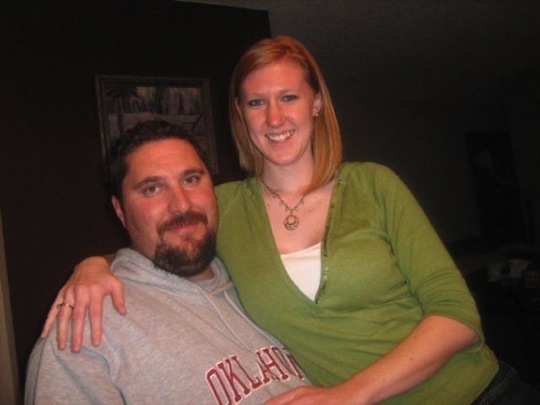
I am also a law enforcement officer, and not being in better shape was a safety concern for me on the job. As an instructor in arrest control techniques and firearms I felt that I was not setting a good example for the other officers. I hated the fact I was becoming the fat doughnut eating cop.

I was eating what I believed was a healthy diet, and I felt I was active. I did not eat out much, and ate home made meals everyday. I grew up with a mother who baked bread everyday, and pastas and even our cereal was homemade. My wife remained in good shape while my weight ballooned over 11 years of marriage.

Last summer I paid a personal trainer, who was a world champion grappler, to help me get in shape. The workouts were very intense, to the point of vomiting after the workout. After months of this I had lost a grand total of 5 lbs, and I eventually gave up the workouts.
One of my co-workers, Greg, a 64 year old man who looks 50 and is ripped, explained the paleo lifestyle to me when I told him about my family’s “Biggest Loser” challenge. I was skeptical since nothing had been working, but obviously it was working for him, so I thought I would give it a try. Greg gave me the Mark’s Daily Apple website and told me about getting cookbooks and other resources.
I explained to my wife the diet and I could not have asked for a more supportive spouse. She changed the way she cooked and shopped for food. We commented on the fact that our cupboards were becoming bare from the lack of processed food, but our fridge was overflowing with meats, vegetables, and other raw foods.
At the end of 6 months the family weighed in to see who had won the challenge. I had dropped from 299 lbs down to 206 lbs, and from 40% body fat to 17%. I not only had won our little family competition, but I was also one of the few that was able to stick to my “diet”. I almost felt guilty with the victory, the weight had come off quickly and easily, I ate when I was hungry, and I ate delicious food.

Besides the weight loss, I also experienced other benefits that I had not expected. I had experienced migraines for years, and have yet to suffer from one since going Primal. My minor hay fever allergies also disappeared. My overall health and energy levels are much improved. I had my my gall bladder taken out two years ago, and had the typical side effects which sent me running for the bathroom. This also went away. I wish I had known about the Primal Blueprint diet before I lost my gall bladder.
I have dropped ten pant sizes, and am now on my fourth gun belt. I look more professional in uniform, and I have other officers asking me how I achieved the weight loss. Two other friends/officers have lost a combined 70 lbs in two months after I convinced them to try going Primal.

It is cliche, but honestly I now feel that I have a new lease on life. With all the health benefits I have experienced since going Primal, I will not go back to eating the typical American diet. I look forward to continuing my transformation, eating well, and feeling young again. Thanks!
Heath
Grab a Copy of The Primal Connection and Take Control of Your Life Today!

February 7, 2013
Push-ups: The Perfect Primal Exercise
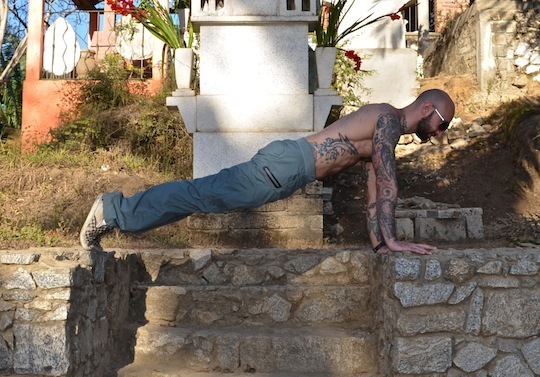 This is a guest post from Al Kavadlo of AlKavadlo.com.
This is a guest post from Al Kavadlo of AlKavadlo.com.
Push-ups are one of the oldest and most widely known strength exercises on Earth. They’ve been a staple in military fitness, martial arts and just about every other type of exercise program that’s ever existed. Anyone who has even the slightest interest in working out has probably tried to do a push-up at least once in their life.
Funny thing is, amongst many modern fitness enthusiasts, the push-up is often overlooked due to its simplicity. A lot of people are under the misconception that something so basic couldn’t possibly be the best overall upper-body exercise out there. Even members of the primal community who know better than to buy into mainstream hype are often skeptical of my claim that the humble push-up is nature’s perfect exercise.
I hope you’re at least willing to hear me out.
Perfect Push-up

Push-ups are as close to a perfect exercise as you can get. They work your entire upper-body (including your abs), and can be modified in an infinite number of ways to suit any fitness level. Push-ups emphasize the chest, shoulders and triceps but every muscle in the body has to do its part for a proper push-up to take place. Your lats, traps and abs must stabilize your pushing muscles, while your lower back, legs and glutes need to stay engaged to keep your hips from sagging or piking up too high. Like many calisthenics exercises, push-ups teach your muscles to work in harmony with one another.
But my favorite thing about push-ups is that they don’t require anything more than a floor, so you can do them anywhere. And as I always say, If you don’t have a floor, you’ve got much bigger problems!
Wall Push-up

Everyone knows strength training is great for your muscles, but a lot of people don’t realize that working out also does a lot for your bones, tendons and other connective tissue. It’s true though; strength training makes the entire body strong. It’s obvious when you really think about it – your connective tissue needs to be strong to support those muscles! Sometimes people are so concerned with aesthetic goals that they overlook the changes that can’t visibly be seen.
If you have bad shoulders, wrists or elbows, in time your joints can be restored with lower intensity variants like the wall push-up. The body can only be as strong as its weakest link, and connective tissue tends to be slower to adapt than muscle. A novice or an injured person should start with the wall push-up, working to 20 and eventually 50 consecutive reps in each set before moving on. To perform this variant, simply lean against a wall with your toes a few feet away and do the push-up movement from this semi-upright position.
Incline Push-up
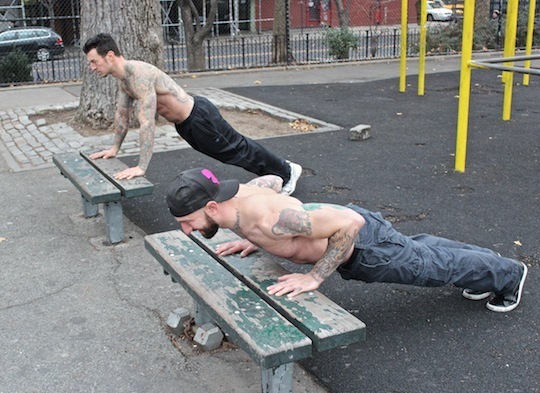
If wall push-ups have gotten too easy for you, but full push-ups are still out of reach, incline push-ups can be a nice intermediate step. In fact, they can be several intermediate steps. The higher your incline, the easier the push-up will be, the lower the incline, the harder it becomes. A high incline eventually becomes a wall push-up and a low incline eventually becomes a regular push-up but there are many levels in between. You can experiment with various household objects or things you may come across outdoors to find ways to incrementally lower yourself toward the floor.
Full Push-up

When doing push-ups, I recommend placing your hands just wider than your shoulders (your thumbs should wind up right beneath your armpits). Keep your elbows fairly close to your body and point them back; do not flare them out to the sides. Lower until your chest is just above the floor, pause for a split second and then press yourself back up.
Many beginners have trouble going low enough on their push-ups. Sometimes this is also the case for people who’ve practiced for years. Your arms should bend past 90 degrees as measured along the outside of your elbow for the rep to count; the lower the better. You may find it helpful to place a tennis ball, brick or other object on the ground under your chest in order to have a reference point for how low to go. You could even try to touch your chest to the floor if you want to extend the range of motion. The ability to do clean chest-to-floor push-ups with proper alignment demonstrates excellent strength and mobility in the upper-body. You might not be here yet, but it should be an eventual milestone. If you don’t get in the habit of performing your push-ups with a full range of motion, you will not get the most out of them.
Diamond Push-up
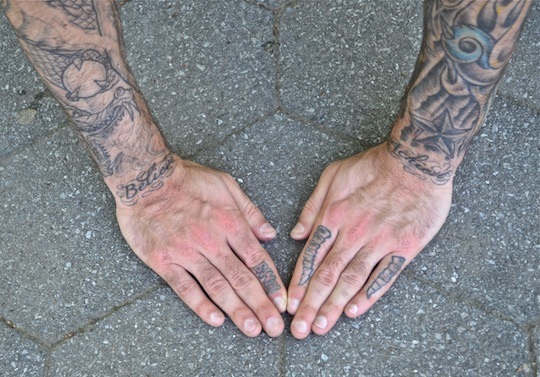
Generally speaking, the closer you keep your hands during push-ups, the harder the exercise is going to be, it’s simply a matter of leverage. The classic “diamond push-up” is probably the most well known of the close grip push-up variations. Before you start working on these, make sure you can do at least twenty standard push-ups.
A diamond push-up involves keeping your hands close enough to touch the tips of your index fingers and thumbs to each other, making a diamond-like shape of those four digits. Be careful not to flare your elbows out when you perform diamond push-ups, as doing so can be troublesome for your joints and less effective for your muscles. You’ve gotta keep your elbows right by your sides. I actually find it preferable to keep my hands in more of an arrowhead shape with my thumbs tucked in, rather than a traditional diamond. This makes angling my elbows closer to my torso more natural.
When performing diamonds (or arrowheads), make sure to go all the way down until your hands touch your chest with your forearms grazing your ribs at the bottom. It’s also important to stay aware of your alignment. It’s common for people to leave their hips too low when performing this exercise. Remember to keep your abs, legs and glutes tight.
Knuckle Push-up

Doing push-ups on your fists is totally badass, plus knuckle push-ups allow for a bigger range of motion than flat palm push-ups. That extra few inches of depth can make repping out a lot more challenging.
While some people’s wrists may need time to acclimate to the extra work required to maintain stability during a knuckle push-up, for others, the neutral wrist position can actually make the push-up less stressful than having the wrists bent back. The skin on your hands may be sensitive when starting out, so the simple discomfort of supporting your weight on your knuckles might be an additional obstacle. You may want to start out practicing on a soft surface for this reason.
Plyometric Push-up
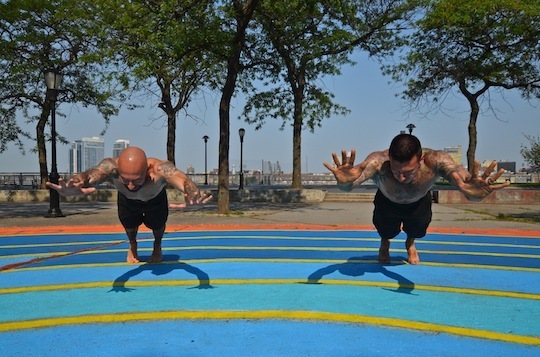
The term “plyometrics” is just a fancy way of talking about explosive movements. Anytime you get airborne while doing an exercise, it’s a plyo. There are many different types of plyometric push-ups, and you need to be very strong to do any of them. (Remember how I said the push-up can be modified to suit any fitness level?)
The most common type of plyometric push-up is the clap push-up. As the name implies, the objective is to clap your hands in the air at the top of your push-up and return them to the ground before you fall on your face. But just in case, you might want to practice on a soft surface when starting out. Also be mindful to absorb the impact during the lowering phase and avoid landing with your elbows extended.
When performing plyo push-ups, aim to be as explosive as possible. Your objective should be to push your body as far away from the ground as you can. While speed is an important part of performing a clap push-up, getting your body high enough is what will eventually allow you to perform a behind-the-back clap, double clap or superman push-up.
Push Yourself
The push-up is one exercise that can continually be adapted to suit your needs; the variations I’ve discussed here are barely the tip of the iceberg. There are many other two-arm push-up variants you can experiment with – and when those cease to be a challenge, there are also plenty of one-arm options. Watch the video below for a demonstration of progressively harder push-up modifications, from the beginner’s incline push-up all the up through some pretty intense single-arm variations.
Nobody’s Perfect
I’m the first to admit that nothing can ever be truly perfect, but the push-up is about as close as it gets. We as humans are constantly looking for a better way to do things, but sometimes the way we’ve already been doing it is the best way. I’ve tried just about every type of workout under the sun and the push-up is as good of an exercise as there will ever be. But don’t take my word for it, give some of these variations a shot and see for yourself!
This post contains excerpts from Al’s new book, Pushing The Limits! – Total Body Strength With No Equipment.

February 6, 2013
Now Offering Primal Blueprint Email Support, Meal Plans and More!
A few weeks ago I announced major plans to help you make 2013 your best year yet. Since then I released The Primal Connection and launched PrimalBlueprintPublishing.com, my team held a Primal seminar and cooking class in Phoenix, AZ, and this last weekend was the inaugural Luxury Retreat in Malibu, CA. But I promised much more. Today, I’m happy to announce a variety of new ways to help you achieve your health and wellness goals with the Primal Blueprint. Today’s post details the launch of several new products and services to help you get and stay Primal in 2013 and beyond. Take a look and see what interests you the most. Please call 888-774-6259 or email with questions about these offerings. Our staff is waiting to help!
Primal Blueprint Email Support
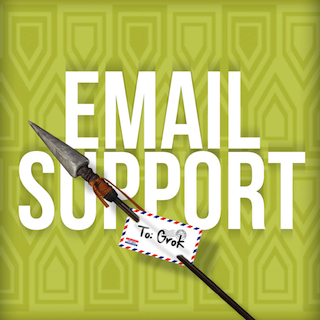 I’ve received more requests for one-on-one support than for probably just about anything else in recent years. I get hundreds of emails every day from people looking for personalized help and answers to questions about their unique health issues. While I try to answer each and every email that hits my inbox, many questions deserve much more time and care than I can provide alone. Now, with Primal Blueprint Email Support you can get your very own personal coach to engage in unlimited email communication relating to your diet, your fitness routine, and all of your other Primal Blueprint-related goals. You can enjoy this service as needed, on a month-to-month basis, for just $9.99/mo. Upon your enrollment, you will be assigned a coach, who has been extensively trained for this role and certified as a Primal Blueprint expert (we will offer this certification course to the public later this year, stay tuned…). I’ll be hands-on, overseeing the entire operation and coaching strategy. All communications with your coach are strictly confidential and we will support you at whatever intensive level you require to ensure your journey is successful. To learn more about Primal Blueprint Email Support and to begin your subscription, visit the Email Support page.
I’ve received more requests for one-on-one support than for probably just about anything else in recent years. I get hundreds of emails every day from people looking for personalized help and answers to questions about their unique health issues. While I try to answer each and every email that hits my inbox, many questions deserve much more time and care than I can provide alone. Now, with Primal Blueprint Email Support you can get your very own personal coach to engage in unlimited email communication relating to your diet, your fitness routine, and all of your other Primal Blueprint-related goals. You can enjoy this service as needed, on a month-to-month basis, for just $9.99/mo. Upon your enrollment, you will be assigned a coach, who has been extensively trained for this role and certified as a Primal Blueprint expert (we will offer this certification course to the public later this year, stay tuned…). I’ll be hands-on, overseeing the entire operation and coaching strategy. All communications with your coach are strictly confidential and we will support you at whatever intensive level you require to ensure your journey is successful. To learn more about Primal Blueprint Email Support and to begin your subscription, visit the Email Support page.
Primal Blueprint Meal Plan
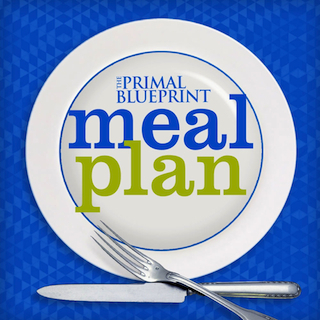 The Primal Blueprint eating strategy is simple – eat meat, fish, fowl, eggs, veggies, fruits, nuts and seeds, and a little bit of high-fat dairy. But simple doesn’t mean it’s always easy. Planning for meals and foraging for ingredients can be a challenge – especially if you are new to the Primal Blueprint eating strategy. That’s where the Primal Blueprint Meal Plan comes in. With the Meal Plan, grocery shopping will be a focused, efficient exercise instead of an exercise in frustration and confusion. All your Primal meals are planned out for you, and there are simple recipes to guide you through every meal. The Meal Plan saves you time by presenting recipes that generate ample leftovers. This allows you to plan ahead and make the most hectic times of the week the easiest when it comes to eating.
The Primal Blueprint eating strategy is simple – eat meat, fish, fowl, eggs, veggies, fruits, nuts and seeds, and a little bit of high-fat dairy. But simple doesn’t mean it’s always easy. Planning for meals and foraging for ingredients can be a challenge – especially if you are new to the Primal Blueprint eating strategy. That’s where the Primal Blueprint Meal Plan comes in. With the Meal Plan, grocery shopping will be a focused, efficient exercise instead of an exercise in frustration and confusion. All your Primal meals are planned out for you, and there are simple recipes to guide you through every meal. The Meal Plan saves you time by presenting recipes that generate ample leftovers. This allows you to plan ahead and make the most hectic times of the week the easiest when it comes to eating.
For just $9.99/mo, the Primal Blueprint Meal Plan delivers new shopping lists, meal plans, and recipes directly to your email inbox every week. If you could use some help organizing your weekly meals and shopping list, and find value in being told exactly what to eat each day to achieve your ideal body composition, this plan is for you. Learn more about the Primal Blueprint Meal Plan, and begin your subscription here.
Get Primal Blueprint Email Support and the Primal Blueprint Meal Plan at a reduced monthly rate ($14.99) when ordered together. Learn all the details here.
Primal Fuel 15-Serving Option
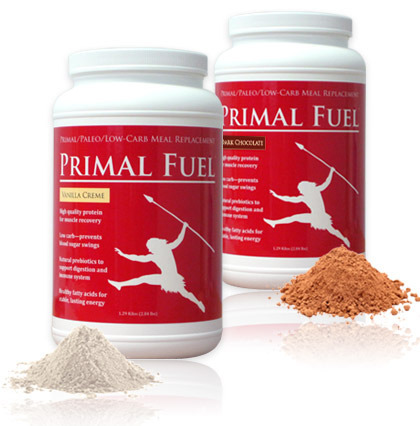 When I first released Primal Fuel I pledged to lower the price of it when and where I could (without cutting any corners on quality) through volume sales and larger ingredient buys. With our outstanding initial response to the product, I indeed lowered the price of the 30-serving jug by $10 back in 2012. I have also recently replaced the HDPE canister with a new easier-to-ship and more environmentally friendly poly bag (not pictured).
When I first released Primal Fuel I pledged to lower the price of it when and where I could (without cutting any corners on quality) through volume sales and larger ingredient buys. With our outstanding initial response to the product, I indeed lowered the price of the 30-serving jug by $10 back in 2012. I have also recently replaced the HDPE canister with a new easier-to-ship and more environmentally friendly poly bag (not pictured).
Now, in a continued effort to make Primal Fuel more accessible and affordable, I’ve listened to your requests for a smaller canister option. You can now purchase Primal Fuel in a 15-serving supply at close to half the cost of the 30-serving canister. At only $2.66 per serving, it’s the perfect high-protein, moderate-fat, low-carb meal replacement shake. It’s the most convenient, cost-effective way to enjoy great nutrition and stay Primal when you’re pressed for time. And as thousands of Primal Fuel customers can attest, both flavors (Chocolate Coconut and Vanilla Coconut Creme) are absolutely delicious, too! If you’ve been waiting to try Primal Fuel, there’s no better time than now. To order the 15-Serving Primal Fuel, simply select “15 Serving” before adding Primal Fuel to your shopping cart.
The Primal Blueprint 21-Day Transformation Program
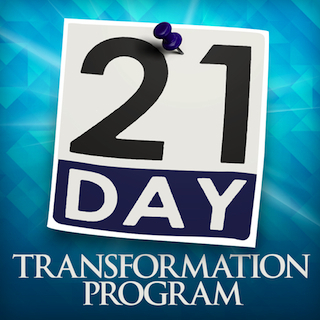 Remember the Primal Leap Kit? Well, it’s been out of stock for a number of months as we’ve been retooling the package. The new kit, now available, is called the 21-Day Transformation Program. This comprehensive package delivers everything you need to reduce excess body fat with certainty and safety in a short time. The Transformation program is comprised of multi-media material and online support features (including a month of one-on-one email support from an expert coach), the centerpiece being The Primal Blueprint 21-Day Total Body Transformation guidebook and journal. In addition to the book, you’ll receive:
Remember the Primal Leap Kit? Well, it’s been out of stock for a number of months as we’ve been retooling the package. The new kit, now available, is called the 21-Day Transformation Program. This comprehensive package delivers everything you need to reduce excess body fat with certainty and safety in a short time. The Transformation program is comprised of multi-media material and online support features (including a month of one-on-one email support from an expert coach), the centerpiece being The Primal Blueprint 21-Day Total Body Transformation guidebook and journal. In addition to the book, you’ll receive:
The Primal Blueprint 90-Day Journal
Primal Blueprint Quick & Easy Meals
The Primal Blueprint Transformation Seminar DVD (Filmed live at a sold out event I held in Chicago last year, this DVD is exclusive to this package.)
The Primal Blueprint Audiobook (MP3)
Primal Blueprint Email Support (First month for free, billed at $7.49 per month thereafter. Cancel at any time.)
Primal Blueprint Meal Plan (First month for free, billed at $7.50 per month thereafter. Cancel at any time.)
21 Days of Inspiration Emails
Primal Fuel – 15-Serving Canister (First month for free, billed at the reduced rate of $34.95 per month thereafter. Cancel at any time.)
Primal Fuel Blender Bottle
Primal Blueprint Poster
Primal Blueprint Wristband
Primal Blueprint Drawstring Backpack
Additionally, as a 21-Day Transformation Program customer you will receive a discount code giving you 25% off your next Primal Blueprint order AND will receive a 10% lifetime discount for all future orders (excluding Events). You get all this (retail value over $200) for just $127.
If you or anyone you know has struggled to transition to Primal eating, struggled to lose fat or keep it off, or requires intensive support to kick-start a 21-day lifestyle transformation, this program is the ticket. It’s simply everything you need to go Primal and do it the right way in a single package, and your results – for once and for all – are guaranteed or your money back. Learn more here.
Need Help Going Primal? We’ve got you covered. Choose the Package That’s Right for You Here.

February 5, 2013
Wearing a Baby: What To Do and What Not To Do
 Last week, I made the case for wearing and carrying your babies, highlighting the considerable evidence of benefit of the practice. Today, I’m going to discuss what to look for when you carry a baby. I’ll also explain what not to do, as well as give a brief rundown of the unresolved topics. Some people might balk at the idea of “learning” how to carry or wear a baby. After all, we’ve been carrying and wearing small, defenseless pudgy humans for millions of years without a blog or a book telling us how to do it. What’s changed to make us suddenly need it?
Last week, I made the case for wearing and carrying your babies, highlighting the considerable evidence of benefit of the practice. Today, I’m going to discuss what to look for when you carry a baby. I’ll also explain what not to do, as well as give a brief rundown of the unresolved topics. Some people might balk at the idea of “learning” how to carry or wear a baby. After all, we’ve been carrying and wearing small, defenseless pudgy humans for millions of years without a blog or a book telling us how to do it. What’s changed to make us suddenly need it?
Not much has changed, actually. Back in the days before widely disseminated, publicly available child-rearing information, we had mothers, aunts, grannies, cousins, plus their male counterparts, to help us out. They’d learned from someone else, they’d done it themselves, and now they were there to show and tell the next batch of parents how to do things. They were the blogs and the books and the experts. It was a culture of baby wearing, too. It permeated the environment. There were no strollers; this is just what was done. You weren’t “expected” to wear your kid. There just wasn’t any other option, and so you knew how to do it.
Today, in the States and most other Western countries, it’s a stroller culture. I’m not saying there’s anything wrong with strollers, mind you. It’s just that millions of adults become parents without ever knowing that baby wearing is even an option. That needs to change.
Although it’s been years since I’ve handled my own infants, and my grown-up kids haven’t produced any of their own for me to tinker with, I know a little something about the subject. I have fairly extensive baby-wrangling experience. While it’s years removed from the present, I still find this an interesting topic because it’s yet another example of how we moderns can learn from the past.
First, let’s start with some “universal truths.” Baby-wearing-and-carrying methodology can be a hotly contested area of study, but I think everyone can agree with the following.
What’s Good
Generally, the higher up on your body the baby is, the easier it’ll be on your back. If you’ve ever done a front squat, you’ll know how much torso strength supporting a weight in front of your body requires. You also know that allowing your elbows to sag and the bar to droop down makes staying upright hard, and it renders the rep nearly impossible to complete. Think of the baby as a barbell. Don’t let the baby droop down.
The closer your baby is to you, the easier it’ll be on your body. Same concept as above applies: keeping a weight close to you makes it lighter.
Supporting the baby’s head. A newborn baby is a weird cartilaginous thing, all bendy and floppy. Babies don’t have the strength to support the disproportionately large head lolling around on top of their scrawny bodies. Whether you’re carrying or wearing the baby, make sure to support the head.
Avoiding excessive chin tucking. The head can go too far forward, too. If that happens and the chin rests firmly against the chest, a baby’s oxygen supply may get cut off. Make sure you can slip a couple fingers between the chin and chest (kinda like checking for a dog collar’s tightness).
Keeping it tight. As mentioned above, maintaining a snug-fitting carrier will keep the baby closer to you and reduce strain on your body, but it will also keep the baby from slumping. A nice way to check if the carrier is snug enough is to press on the kid’s back. If the kid moves toward you, the carrier isn’t snug enough.
Maintaining line of sight. Make sure you can always see your baby. If the baby’s in the front, you shouldn’t have to brush aside any fabric to see him. If the baby’s on a back carrier, you should be able to look over your shoulder and see him. On that note, don’t cover your baby’s head in fabric.
Keeping a supported back. Don’t let a baby slump forward into C-shaped hyperflexion and don’t let the spine drift into hyper extension of the lower. Keep things supported (babies will naturally gravitate toward a slight C-shape).
Frog stance. A baby’s knees should be above his butt, at around 90-100 degree flexion, with legs spread. Like a frog, or, like the bottom of a squat. The butt and upper hamstrings should be supported, because a little baby can’t be expected to keep his legs up on his own.
What’s Bad
Dangling, straight legs. Babies aren’t meant to hang ramrod straight. The only reason a worn baby’s legs would be straight is if he were only held up by his crotch without any butt or hamstring support. According to the International Hip Dysplasia Institute, babies with dangling, straight legs are at risk of developing hip dysplasia.
Intense exercise. I don’t care if you saw some guy doing kipping pullups while wearing his kid in a Baby Bjorn and it looked really sweet. Don’t perform intense exercise while wearing your baby. Don’t sprint, don’t run, don’t play on a trampoline.
Getting comfortable with bad form. Just like beginners to weight lifting can get away with poor form when they’re just lifting the bar, you can get away with inefficient carrying and wearing methods when your babies are just ten or fifteen pounds. Once that kid starts to hit the 20, 25 pound range, though, you will pay the price for improper form. You might stop carrying altogether when all you really need is a different carrier or a better method, and then your kid will suffer.
Using a wrap, sling, or carrier without knowing how. Some of the carriers are simple, but others take some instruction and know-how. This is your baby’s life we’re talking about; don’t create your own method of wrapping a baby without knowing what you’re doing. Don’t wing it.
Failing to heed “What’s Good.” Do that stuff. Seriously.
Points of Contention
Not everyone can agree on everything.
Inward Facing versus Outward Facing
I’ve heard it said that worn or carried babies should be facing outward so that they can see what you’re seeing and get sensory stimulation from the outside world. After all, one of the downsides of exclusive stroller living is that the kid never gets to see much of the world. Facing your child outward would seem to take care of this issue pretty conclusively.
I’ve also heard that outward facing babies get too much stimulation, that for a budding sensory system the sights of the scary new world might be excessive and even damaging. Think of the principle of acute vs. chronic stress. For a tiny baby with a couple weeks or months under his belt, the simple (to us) act of looking around is an incredibly stimulating event. Almost everything they see – a traffic light, a dog, a tree, a passerby, a store sign, a fence – is entirely novel. They don’t even have a way to intellectually process what they’re seeing. They just see these amazing bright colorful images. It’s a bit of a stress, in a way, because it’s so new, and I can see the argument for limiting visual stimulation.
There’s also the fact that the natural position of a baby is the frog stance, where the knees are in 90-100 degrees flexion (so knees above butt) and the legs are somewhat spread apart (whatever’s comfortable). An inward facing baby can draw his legs up against the parent and straddle her. If the kid is outward facing in a carrier, reaching that froggy squat stance could be tough without the parent’s body to brace against. His legs may just dangle and his butt and hips won’t get any support.
Since an outward facing baby’s limbs will be further away from the parent than the limbs of an inward facing baby, the former position may be harder on the parent’s lower back.
I think a great compromise is to wear the baby on your back facing forward. That way, the baby gets plenty of opportunities to take in the outside world while reserving the ability to bury his face in your shoulder if it gets to be a bit much. The legs are supported, the froggy-style simulated squat is promoted, and the back is an arguably easier way to support weight (consider that a person’s back squat ability is generally greater than their front squat ability). Plus, Esther Gokhale, my go-to source for all things healthy posture-related, prefers the back carriers. Most evidence I’ve seen suggests that traditional cultures tended to favor wearing babies on the back, probably because it allowed the parent to keep up with work, though it definitely varies.
Bag Slings
The bag sling is exactly what it sounds like: a sling slung over the shoulder with a compartment in the bottom for the baby. They appear to be the simplest method of wearing a baby – you essentially just sling it over your shoulder and drop the kid in – but several safety concerns have been raised. To summarize from that link:
1. Bag slings are “triangular,” with a flat bottom and two sides that converge. This effectively closes the baby in, possibly restricting air flow, and if a baby turns his head to either side, his face will be pressed up against the fabric.
2. The further the baby sinks into the depths of the bag, the more the top closes. This could prevent the parent from keeping a watchful eye on the baby.
3. If the top of the bag is closed, air flow will be disrupted. The baby may overheat or asphyxiate unless the bag is outfitted with mesh.
4. The design of a bag often promotes the chin-to-chest position that we want to avoid.
Some bag slings have even been subject to recall notices following infant deaths. Of course, plenty of parents have used bag slings without an issue. If you use one, just be extra careful and don’t let the little one sag too low.
As I said, Carrie and I never did the sling or baby carrier thing. We were the carriers. So I can’t give you my honest opinion on what works and what doesn’t when it comes to carriers, slings, and other things, because I don’t know for sure. What I can do is give a basic rundown and then direct you to dedicated online resources that should help you make the choice.
That will have to wait til next time, though, because this post is already lengthy. Until then, take care and be sure to leave a comment. Did I miss any tips, make any mistakes? Let us all know!
Get All Three Primal Cookbooks, an Apron and More in The Primal Blueprint Chef Kit Today!

February 4, 2013
How to Incorporate the Primal Blueprint into a Busy Family and Work Life
 Instead of Monday’s regular Dear Mark post, today I have the pleasure of bringing you a fantastic guest article from Mark’s Daily Apple reader Paul Attia.
Instead of Monday’s regular Dear Mark post, today I have the pleasure of bringing you a fantastic guest article from Mark’s Daily Apple reader Paul Attia.
At the age of 24, I was a two-sport varsity athlete while in law school; I thought I was busy. A very “short” decade later, I was a trial lawyer with an intense job as a criminal prosecutor, I was married, and I had three kids under the age of three; then I understood what being busy actually meant. In the intervening period, however, I needed to learn much and adapt vastly, my own lifestyle goals and patterns in order to continue to achieve some goals that I had set for myself. During that same period, I was introduced to the Primal Blueprint (via my brother Peter, whom many of you know).
My goals are very similar, no doubt, to the goals shared by many of you. Namely, I want to be the best spouse I can be; the best father possible; the consummate professional in my job; and live a very full and healthy lifestyle. Goals, as many of you know, are tantamount to looking at a road map and selecting a destination; goals tell you where you want to go. But selecting and following the best route to your chosen destination is what will determine whether you arrive or not. I am writing today to let you know how incorporating the PB into my life is helping me reach that destination; I believe that my experiences will be very similar to yours and that today’s article will equip some of you with ways in which you can incorporate the PB into your busy family and work life.
To that end, and in keeping with my profession as a trial lawyer, I shall break my writing down into three separate but related parts: Fit Father vs. Fat Father; Primal Parenting; and Executive Workouts.
Fit Father vs. Fat Father
As you can deduce from the above, my transition into fatherhood was a rapid one. On my 30th birthday, I was unmarried with no children. By the age of 34, I was married and we had three kids. My wife and I have very similar backgrounds. She was a national champion in track and field, and went on to have a very successful university career in track, as a two-time conference champion. We are both very intense in the pursuit of our passions. So, once we were married, we decided to take the same approach to our family. We wanted a large family and we wanted to build one at a fast pace.
When I became a father, I recognized early on that I had to make a choice as to whether or not I wanted to be a Fit Father or a Fat Father. I also knew that to “not make a choice” was indeed to make a choice; and that would be a choice for the latter, i.e. one has to pro-actively and actively choose to be a Fit Father.
It is important to be aware of two critical factors that occur when a man becomes a father. One, the amount of “tasks” in your daily life increases at an exponential rate; simultaneously, the amount of time you have to complete said tasks decreases at an exponential rate! It is at this intersection that many become fat fathers as opposed to fit fathers. Most other dads that I talk to will share similar stories: They were young and healthy, keeping fit by either exercising (jogging, biking, etc.) on a consistent basis, or playing a sport often (Ultimate Frisbee, baske-ball, etc.), until they had a kid. Soon, times for morning or evening jogs were gone; taking off to the gym was no longer an option; and evening games of Ultimate could not be attended. Soon, the desire to “get back into it” also decreased.
This touches on another important principle at play: the longer one has gone without being physically active, the more difficult it is to return.
So, how do we, as parents of young children (I am writing this to fathers, but many of the principles apply equally to mothers), change this, and ensure that we can be Fit Fathers (and Mothers)?
Let’s take a look at First Principles.
One, choose, in your mind, that it is a goal of yours. If it is not even set as an objective, you’ve really got no chance. Two, decide to make subtle changes, consistently, over a long period of time. Yes, that is right, you heard me correctly: Subtle changes; Consistently; Over a Long Period of Time. The PB is about changing your lifestyle in such a way that you can maintain it… It is Not about implementing methods that you can only maintain for a short period of time. That is an important distinction. Three, decide what those changes will be and implement them. They may be related to the type of exercise, location of it, or duration. They may be related to how you eat, what and how much. They may be related to your sleeping habits, your social choices, or decisions about your attitude. They may include all of the above.
I’ll give you a few examples that I used in my life. One, I made a choice that I wanted to be a Fit Father (my reasons for this choice shall be explained below). Two, I determined that I needed to make some changes in my life; I needed to change the way I viewed exercise; and that I needed to change the way I ate. As a varsity athlete, my idea of a workout included a trip to the gym and hours spent there. Once I became a father, opportunities to take off to the gym for hours on end, disappeared. Therefore, I had to change my idea as to what a workout was. Once I realized that a workout could take shape in a number of different ways, in different locations, with little to no equipment, I quickly realized that I could in fact be active daily. And that was my first goal: Do something physically active each day. Sometimes that might be a trip to the gym. Sometimes it might be a mountain bike ride for an hour. Sometimes it might be a 10-20 minute “Executive Workout” (see more below). Some days it’s my commute to work and then a few sets of pullups and pushups once I am there. And some days, it might just be a hike in the woods with my kids, as we run around and explore. Either way, I am physically active every day.
I also changed the way I ate. I realized that as a man in his mid-thirties, I could not eat the way I ate in my mid-teens or even mid-twenties for that matter. I implemented the PB into my life and realized that eating this way was almost like I was “cheating” because it was so easy. I eat as often as I want and as much as I want. I just choose to eat from a list of foods that are ideal; I choose to never eat from a list of foods that are poison (read: sugar); and I sometimes eat from a list of foods that are okay. Basically, my diet is very simple: I eat lots of fruit, tons of vegetables; some good meat; and zero wheat. Sugar is a poison. I try not to eat poison.
I implemented the above changes subtly, but consistently, and have now been doing them for a long period of time. The results have been very rewarding. I am healthier, fitter, stronger and more energetic at this stage than I was before.
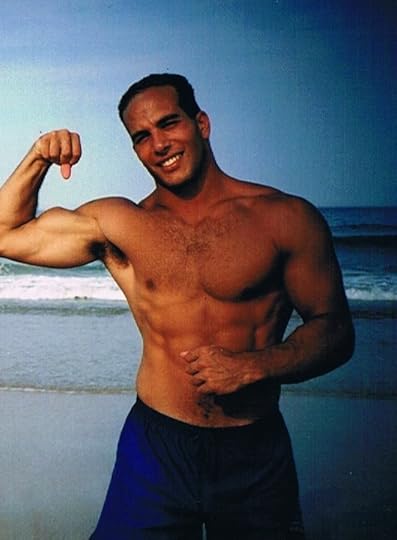
Here is one other major advantage – and in fact, the most important one: I am happier. And as result, I am a better father.
You see, being a Fit Father vs. a Fat Father appears on its face to really be a decision that is all about you as a father. But it is not. It is really a decision about what is best for your kids. That may sound paradoxical, but it is not. Let me explain.
When you’re fit, you’re happy; when you’re happy, you enjoy your life more; when you enjoy your life more, you enjoy your kids more. It is really very simple.
When I come back from a mountain bike ride in the woods, or a workout out in the park (or at the gym, for that matter), I am feeling physically refreshed, but I am also feeling better about myself mentally. I feel good that I did something productive for myself (as selfish as that might sound) and I can now throw myself fully into time with my kids uninhibited; as opposed to skipping out on exercise in order to be with the kids. That option sounds lovely, but in the long term it renders one unhappy and possibly resenting your family. That is dangerous in the long term.
Of course there are other benefits of being a Fit Father: You have more energy. Playing with your kids is a joy, not a physically tiresome task. In fact, you love it, and often initiate it. They reciprocate in a fantastic fashion and great memories and bonding ensue. You can incorporate physically active family adventures and outings, whether it be a hike, or just playing in the backyard. Being Fit opens doors.
Lastly, when I became a father, a good friend and mentor told me, “do not worry that your kids are not listening to you, but be very worried that your kids are watching you.”
Kids look to us as examples. If you want your kids to be physically active people, who love life, soak up every ounce of it, and pursue it passionately, then don’t tell them to do that, just do that and they’ll probably follow your lead!
Primal Parenting: Implementing the Principles of the PB with a Young Family
Children are inherently primal in so many respects. We can, in fact, learn a great deal from observing them. By nature kids love to move. They are perpetually interested in running, playing, chasing, falling, jumping. You name it. So, let’s encourage that to the max. Set up your life and your home in such a way that play is allowed and encouraged. Put your TV in a room that is far away from the main hangout area; build forts in your living room, not just your backyard; play tag with your kids; take them on hikes and nature walks. Feed them great foods and teach them at a young age how great these foods really are. They will follow our leads. When they see us enjoying fruits and vegetables, nuts and seeds, they’ll follow our lead. Pragmatically, set up your life in such a way that good, healthy food, is readily available.
My days are busy, but they begin very early with our kids and playtime is generally what we’re doing from the get-go. The kids begin their day, running around the living room, chasing dad and playing a sport of sort – even if it is still before 6 am. They love it and always want more. We keep the house full of good snacks – cashews, almonds, cut veggies, fruits and berries are regular snacks for our kids – and “treats” like ice cream are easily made by crushing up a frozen banana with some cocoa powder.
Weekend plans usually involve a hike in the park, climbing “mountains” (i.e. any hill or staircase we can find), and heading to a farmers market for some good snacks and lunch.
Each and every time we implement any of the above mentioned practices, the kids seem to love it more and more; showing me just how “primal” we really are.
Primal “Executive” Workouts: How to Incorporate PB Workouts into a Very Busy Schedule
Like so many of you, my days seem to be becoming busier and busier. “When will my schedule settle down?,” I often ask myself. Well, I think I’ve stopped waiting for an answer. Between the three kids under three and my days in court, the “windows of time” for me to go to the gym only seem to be getting smaller. My experience is not unique, I know.
To solve this problem, we need to become creative in our implementation of a PB lifestyle, in spite of our busy and hectic schedules.
I began drafting “Executive Workouts” when I first starting working as a lawyer, nearly a decade ago, as my schedule was becoming increasingly busy I called them “Executive” in that they are Efficient and Effective – and because they are most useful to people with busy lives.
After reading the PB, I began to implement Primal components into my Executive Workouts, and now enjoy them that much more.
Let’s go back to first principles – and let’s be pragmatic. What task(s) are you doing every day? The answer is likely commuting to work, taking a shower, grabbing a meal… etc. So, how can we incorporate exercise and physical activity into those daily tasks? When I began to answer these questions, the answers led me to make some subtle, but very important changes in my life. My commute is now a form of activity. I walk, bike, run or even skate to work (I live near a body of water that freezes in the winter).
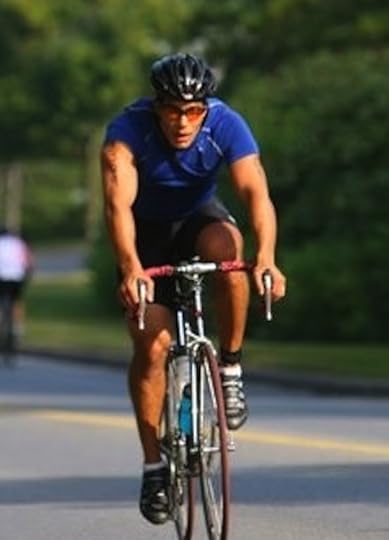
I bought a pullup bar for the doorway of my office at work and of my office at home. I set a goal of doing X amount pullups in the morning before my shower, and a certain amount of pullups once I arrived at working in the morning. That number began in the single digits; within a few months, it was into triple digits.

I bought a resistance band and kept one at home and one at the office; same thing with a set of dumbbells; and I apply the same principles as above. And let’s not forget the good ol’ fashioned pushups, body weight squats, etc. I have now set up a series of “Executive” Workouts that I can do virtually anywhere, with little or even no equipment, and I work these exercises into my daily life, whether it be 5 minutes before I jump in the shower or 10 minutes first thing in the morning, doesn’t really matter. The point is, that I have worked physical activity into my daily life in a way that is easy and simple to implement.
My current schedule (read: deal with my wife), is that I take off to the gym very early on Tuesday and Thursday mornings (and often on Saturday mornings). On the other days of the week, however, my mornings are usually spent running around with my kids, playing, making food, changing diapers, “negotiating with them” over what they’re going to wear that day… the list goes on. On those days, my “physical activity” includes my running around and playing with my kids, my commute to work, and I’ll add in a Primal “Executive” Workout, such as the following:
2 minutes of Core Pushups*
4 minutes of Body Weight Squats
2 minutes of Pullups, completing a total of 50 in that time period
2 minutes of Core Pushups
Total: 10 minutes
*(Core Pushups involve doing 1 push every 5 seconds for the duration of the set, e.g. here I’d do 1 pushup every 5 seconds for a 2 minutes straight, thus essentially doing a “plank” in between pushups).
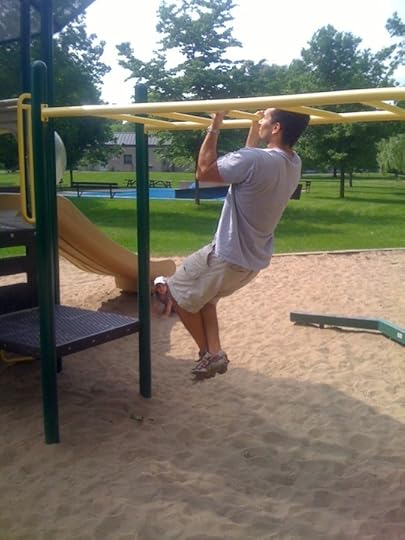
Here are some other practical examples of ways in which I have incorporated workouts in my every day life, that may work for you as well:
I may bike or run to work, stopping at a nearby hill to run sprints, intervals of timed pushups, or pullups from tree branches.
When working on a long and intense trial at work that occupies days, mornings, and nights, I’ll run the couple of miles to work and back, setting my watch timer to beep every minute, reminding me to stop and do a set of pushups. By the time I’ve commuted to and from work, I’ve run several miles and done hundreds of pushups, but really have not taken very much time out of my day.
As mentioned above, I have a pullup bar, dumbbells and a set of resistance bands in my home office and my office at work, so I can never have an excuse to not get a workout in.
Commit to doing a certain number of pullups every day on the way in or way out;
Set your smart phone timer to go off once per hour as cue to get up from your desk and to do a set of pullups and pushups
Take 20 minutes over lunch and do a workout on the equipment right around you
At home, I’ve set up a large, kids play area near an exercise area for myself, so that I can also exercise at home, with my kids right there.
In warmer months, I’ll head to the park with my kids and set up a circuit wherein I may run from the monkey bars (doing pullups) to a bench (for steps ups) back to the sand box (for sprints). My kids think it is hilarious to see their dad get tired and they turn it into a game for them too.
In the winter, rather than driving places, I’ll pull my kids in a sled. They enjoy it much more and it turns into great exercise for me (pulling 2-3 kids in a sled, through a few feet of snow has the tendency to do that).

You’ll be amazed at how fantastic you feel after a quick, short, and intense workout like that. You, of course, all know that from your experiences to date, with the Primal Blueprint.
I hope and trust that my experiences with the PB will assist and encourage many of you to find creative and practical ways to incorporate the PB into your busy family and work lives as you all aim to be Fit Fathers and Mothers, Primal Parents and members of the Executive Team.
All the best,
Paul Attia
Fit Father vs. Fat Father Summary
Two things happen when you become a parent: your amount of tasks goes way up and the amount of time you have goes way down. It is at this intersection that many people falter.
Choose to be a Fit Parent.
Make subtle changes, consistently, over a long period of time.
Incorporate physical activity into everyday life, recognizing that your life as a parent is very busy, and likely will not slow down, so you have to adapt.
Create some easy ways to make practical changes:
Turn your commute into a form of exercise (walk, run, or bike to work, stopping at a hill for sprints, or pushups on the way).
Throw a pullup bar, set of dumbbells, or a resistance band in your home or work office and set some fun, daily or weekly goals for yourself.
Learn to do Executive Workouts (see main article).
Incorporate your kids into exercise (circuits in the park, bike rides, runs, hikes, sledding in the winter).
Set up easy ways to eat as per the Primal Blueprint, even when on-the-go:
Put a small fridge in your office stocked with fruit and vegetables.
Keep a stash of snacks (nuts, seeds, etc.) nearby.
Find some spots near your office and home that serve up good primal foods, so that you have readily available options when you eat out.
Get the Primal Blueprint Fitness eBook, Free Health Tips and Primal Recipes Delivered to Your Inbox

February 3, 2013
Weekend Link Love
 Research of the Week
Research of the WeekThough most of us think of steaming as a gentler cooking method, a recent study found that steamed salmon had more oxidized cholesterol than pan-fried salmon. However, cooking time may have mattered more than method, since steaming took 12 minutes and frying took just 6.
If you’re gonna do sprint intervals/HIIT with short rest periods, make sure you really rest in between each sprint. Active recovery (where you keep moving during your “rest” periods, albeit at a lower intensity) reduced sprint performance when compared to passive recovery (do nothing; just rest). If you take longer rest periods (100+ seconds), how you recover has no effect.
Interesting Blog Posts
Karen De Coster gives us the scoop on Panera Bread’s “Hidden Menu,” which looks suspiciously familiar.
Is schizophrenia an autoimmune disease?
Media, Schmedia
Thanks to input from Dr. Cate Shanahan and plenty of “pasture-fed beef” and “pasture-fed butter,” the Los Angeles Lakers have seemingly gone Primal. Kobe Bryant specifically credits his newfound focus on diet for much of his continued success on the court.
World-famous and internationally-recognized method actor Ashton Kutcher was recently hospitalized for elevated levels of pancreatic enzymes after following a fruitarian diet in preparation for his role as Steve Jobs.
Everything Else
Suffer from Crohn’s? Know someone who does? Interested in promoting alternative health practices (including ancestral diets) for the resolution of chronic digestive problems? Consider contributing a few bucks to WANTED: Crohn’s End, a new documentary about empowered patients looking for answers outside of standard medical practices that just aren’t working for them.
Got some new apparel up in the Primal Blueprint store: an “In Grok We Trust” keychain and a Grok-embroidered polo shirt. Go check ‘em out.
Recipe Corner
How to make 1000 year old eggs (in just three and a half months).
Impress your friends and feed their gut flora with barbacoa tacos on jicama shells.
Time Capsule
One year ago (Feb 3 – Feb 9)
Is Honey a Safe(r) Sweetener? – Is honey a better choice?
Why You Should Eat Sulfur-Rich Vegetables – Finish your sulfur first and you may be excused.
Comment of the Week
Your mention of McDonalds reminded me of a comedian I once heard. He said that when he was growing up he associated McDonalds with good feelings and would get a warm & happy feeling every time he saw the golden arches. He did not want his children to grow up like this so ever time they drive by he punches them in the arm. NOTE: I’m not advocating child battery!
Get All Three Primal Cookbooks, an Apron and More in The Primal Blueprint Chef Kit Today!

February 2, 2013
Beef Stroganoff
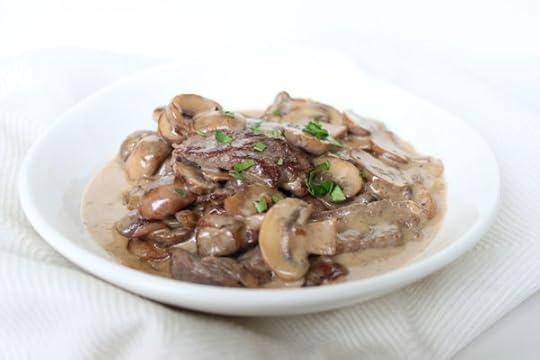 Once thought of as an impressive gourmet dish for dinner parties, Beef Stroganoff is actually easy enough to make any night of the week. It’s essentially nothing more than thin strips of beef simmered in a creamy sauce. But what a delicious sauce it is, meaty and rich, and still guaranteed to impress.
Once thought of as an impressive gourmet dish for dinner parties, Beef Stroganoff is actually easy enough to make any night of the week. It’s essentially nothing more than thin strips of beef simmered in a creamy sauce. But what a delicious sauce it is, meaty and rich, and still guaranteed to impress.
There are several ways to make the creamy sauce, depending on how your body feels about dairy and how you feel about the flavor of coconut milk. This recipe combines 1/2 cup (125 ml) coconut milk with 1 cup (250 ml) whole cream for a decadent-tasting sauce with light coconut flavor. The whole cream can be omitted and 1 1/2 cups (375 ml) of coconut milk can be used instead. You could even omit both the coconut milk and cream and simply serve the meat and simmered stock with a dollop of sour cream. The dish will turn out great no matter what.
Beef Stroganoff was first made in Russia centuries ago. Way back then, stroganoff was served without a carb companion, unless some fried potatoes could be found. Rice and noodles were not part of the original dish so there’s no reason to add them now. The tender beef and mushrooms and flavorful sauce are hearty enough and so delicious that you won’t want a noodle to get in the way.
Serves: 4
Time in the Kitchen: 35 minutes
Ingredients:

1 tablespoon coconut oil (15 ml)
1 1/2 pounds (680 g) beef tenderloin or sirloin, cut into 1/4-inch thick slices (6 mm) that are 2 to 3 inches in length (5 cm to 7.6 cm)
2 tablespoons unsalted butter (30 m)
1/4 cup finely chopped shallots (60 ml)
8 ounces cremini or white mushrooms, thinly sliced (230 g)
1 cup beef stock (250 ml)
1/2 cup coconut milk (125 ml)
1 cup heavy cream (250 ml)
1 tablespoon Dijon mustard (15 ml)
Chopped fresh parsley or dill for an optional garnish
Instructions:
Lightly season the beef with salt and pepper. Heat the coconut oil in a large skillet (12-inch or more) over high heat until the skillet is very hot. Add half of the beef strips, cooking for 1 minute on each side to brown. Put the cooked meat in a bowl. Let the pan heat up again before browning the rest of the meat. Add the second batch of meat to the bowl.

Turn the heat down slightly to medium-high. Add the butter. When it melts, add the shallots. Sauté for just a minute or two then add the mushrooms. Cook the mushrooms until soft and lightly browned, about 5 minutes.
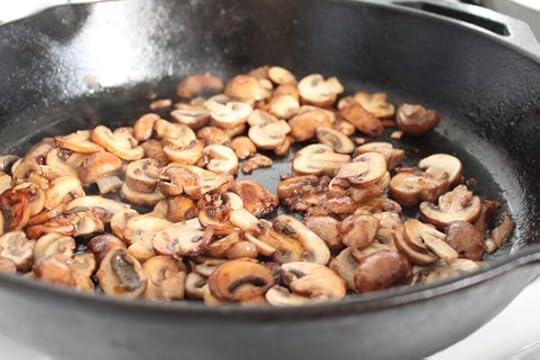
Add the beef stock and coconut milk, scraping the bottom of the skillet to release all the tasty bits stuck to the pan. Boil for 5 minutes.
Whisk in the heavy cream and mustard. Boil for 3 to 5 minutes to thicken the sauce slightly.

Add the meat and any juice that’s collected in the bowl with the meat. Simmer just a few minutes to heat the meat back up.

Add sea salt to taste and serve. Add chopped parsley or dill for garnish if desired.

Get All Three Primal Cookbooks, an Apron and More in The Primal Blueprint Chef Kit Today!

February 1, 2013
A Journey Towards Self-Discovery and Self-Love
It’s Friday, everyone! And that means another Primal Blueprint Real Life Story from a Mark’s Daily Apple reader. If you have your own success story and would like to share it with me and the Mark’s Daily Apple community please contact me here. I’ll continue to publish these each Friday as long as they keep coming in. Thank you for reading!
 Dear Mark,
Dear Mark,
Ever since I stumbled upon your blog a year ago when searching for information on the paleo diet, I’ve always found the success stories to be some of the most motivating personal accounts I’ve ever read. I never thought my transformation would be impressive enough to warrant my own success story, but after sitting down and truly thinking about all the positive changes that have happened in my life since committing to the Primal lifestyle in October, 2011, I wanted to share my story in the hopes that perhaps someone out there can relate to what I’ve gone through.
First, some background information leading up to the day I plunged into Primal living with both feet. As a kid I always suffered from severe eczema on my scalp and hands. I remember being 7 or 8 years old and sitting down every night while my mother massaged this tar-based “medicine” onto my head in the hopes that it would control the eczema. I remember being on puffers for much of my youth and being embarrassed to show people my hands in elementary school, leading to a love affair with long-sleeved t-shirts. Can anyone say food allergy?
As I got older, I seemed to outgrow these symptoms and entered middle school mostly eczema- and puffer-free. I was a fairly active kid all through my youth playing soccer, basketball, and hockey and participating in swimming, horseback riding, and skiing. When I got to grade 8 I started being overwhelmed with body image issues and thus began my 12 year struggle with disordered eating habits and self-loathing tendencies.
Though I was never hospitalized for my issues surrounding food, I would go through phases where I would be exercising 2+ hours a day and eating around 1000-1200 calories a day of CW proscribed “health” foods. I remember being 15 and losing about 20 pounds and being thrilled with all the positive comments I received. Clearly, however, these kinds of eating habits and lifestyle was unsustainable in the long term and so began my cycle of extreme “health and fitness” binges followed by inevitable weight gain. This cycle continued all throughout university and at my heaviest in 3rd year I clocked in at 162 lbs at a height of 5’4″. Even worse than the weight was that I suffered from extreme anxiety for many years and would go through phases where I would be so anxious that I would sit up at night curled in a ball on my bed, afraid to go to sleep for unknown reasons.
Perhaps my most unhealthy cycle began the summer after I finished my undergrad and before I started my MA. It was at this time that I discovered purging via laxatives and realized that I could eat whatever I wanted and have it leave my body as soon as I woke up the next day, ensuring, in my mind, that I would never gain any weight. My anxieties continued to plague me, though not quite as severe as before and the self-loathing I had for my body continued to grow. I hated my binge sessions where I was able to put away two large bags of chips, a family size bag of M&M’s, pizza, fancy cheeses, and other sweets all in one sitting. I would then be so overcome with guilt and anger at my lack of control that I would drive to a twenty-four hour pharmacy to pick up my laxatives and thus the cycle would start anew. At its height, I would sometimes repeat this cycle every day of the week to ensure I stayed a “healthy” weight. This pattern continued for three miserable years as my depression and anxieties grew once again. It always surprised me that I was able to keep this a secret from virtually everyone in my life, and to be honest this is the first time I’ve shared my story. Throughout the duration of my program I would fall into weeks of depression where I would sometimes only leave my bed for two hours a day, tops, and would rarely leave my apartment. On the surface I could make excuses and say I was busy working and because I was always able to put a smile on my face when I did muster up the energy to leave my house, none of my friends suspected the torment I was living with on a daily basis. However, several professional relationships were destroyed due to my inability to complete work on time and I would sometimes go off the radar at school for weeks or months afraid to open the emails asking me where I was. Then, as quickly as these depressive episodes would come on, they would taper off and disappear for a little while. The binging and purging cycle, however, was my constant companion.

A friend of mine in my MA program had told me about the paleo diet when we first started the program in 2009 and I had dabbled on several occasions with the premise, rarely lasting more than a week. Looking back now, I see that during those “experiments” I was binge and purge free for the whole time I was adhering to the diet, but of course some event like a concert or party would come up, and down the rabbit hole I would go, falling back to my habits of late-night pizzas, chips, cookies, and chocolate candies.
Fast-forward to September 2011 and I had just successfully defended my thesis and moved to a new city. I wasn’t quite at my heaviest weight, but I was hovering somewhere between 150-155. I moved in with my sister who has celiac disease and I decided to try cutting gluten out of my diet once and for all. I was still eating all manners of processed foods, but I was becoming more aware of the relationship between food and wellbeing. In October of that year I found MDA and read through the archives like a woman possessed. Everything began to make so much sense! The eczema I had suffered from, the constant illnesses, the fatigue, bloating, and weight gain could all be linked to what I was putting in my body. The next day I cleaned out the cupboards and started living a Primal lifestyle in earnest. And after a few weeks a funny thing happened. I was no longer biting my nails or pulling out my eyelashes, which were telltale signs of anxiousness. I was calmer, happier, and most notably I hadn’t binged or purged in weeks. My skin was clearing up, especially on my back where I had suffered from severe acne since I was a teenager. And I had slimmed down. Not in a dramatic transformation kind of way, but in a way that felt healthy and right. I couldn’t believe it. I had spent so many years trapped in CW’s rendition of “healthy” eating which had never worked for me in any capacity, that I was shocked when food really did seem to be a huge contributing factor to many of my physical and psychological issues. I was so struck by the power food has to heal the body that I completely switched from my path of applying for a PhD in English Lit and applied to a holistic nutrition program and a culinary nutrition program so that I can develop recipes and teach cooking classes.

My goal now is to spread the good food word to any and all of those people who are fed up with CW’s nonsense approach to health and wellness. I’m hoping to eventually start an after-school program that teaches children the importance of putting healthy food in their bodies and to run cooking classes for busy moms and working professionals offering up easy tips and tricks for healthy eating. Stumbling upon your blog was a defining moment in my life. Reading your informative and scientific posts sparked an intense interest in alternative nutrition, which has helped shape the direction of my life from this point on. But most importantly, your blog started me on a journey towards self-discovery and finally self-love, something I had never experienced in any true form up until now. I haven’t binged and purged in almost a year and I’ve discovered a passion for life I never knew I was capable of. So thank you Mark, for doing what you do so generously and with so much passion. Thank you for giving me my life back.

Cheers,
Cait
P.S. I’ve attached a couple of pictures. The first is me at my heaviest in 2007. The second is my brother and I a couple of weeks ago (he has lost over 60 lbs following a Primal lifestyle), and the third is me training for the Wall this past summer 
Get All Three Primal Cookbooks, an Apron and More in The Primal Blueprint Chef Kit Today!

January 31, 2013
Entitled to Sabotage
 Last week’s post on emotional eating got people talking – about the personal struggles they’ve had and the mental games they’ve learned to avoid in their quest for health. One such game, I think, is what we call treating ourselves. How many people justify bad eating habits because they tell themselves they deserve the treat? “Can’t I just enjoy a little pleasure in life?” “Aren’t I entitled?” Sometimes it takes on context. “With all I put up with…” “Why can’t I just have this one thing?” “This is the one thing I do for myself.”
Last week’s post on emotional eating got people talking – about the personal struggles they’ve had and the mental games they’ve learned to avoid in their quest for health. One such game, I think, is what we call treating ourselves. How many people justify bad eating habits because they tell themselves they deserve the treat? “Can’t I just enjoy a little pleasure in life?” “Aren’t I entitled?” Sometimes it takes on context. “With all I put up with…” “Why can’t I just have this one thing?” “This is the one thing I do for myself.”
Treating ourselves. When the noun morphs into the verb, there’s a subtle but significant distinction. Treating ourselves invites us to step outside our normal life for the promise of something of sweeter – and “better.” On occasion, it can be a lighthearted dalliance. For too many people, however, it becomes a continual path of self-sabotage. We all want to believe we deserve more, deserve better than what we come to feel is the mundane. Advertisers leap on this low hanging psychological fruit. Our culture as a whole promotes the immediate gratification of it. There are days when the most resolute among us might at least consider the question. Maybe it’s been one of those days…or years. We’re going through a tough time. We might feel like this momentary extravagance really is all we have to salvage the day.
We can feel like we’re justifiably soothing ourselves or we’re valiantly snubbing our noses at the world that abused us so heinously, but the truth is we’re only robbing ourselves of our own health and wellbeing. Sure, a “treat” distracts us in the moment. The taste, texture, and concept numb us for a short time to whatever emotion, issue, or task we’re hoping to escape. In and of itself as an occasional choice, it doesn’t seem like any real harm. Usually, it isn’t.
The problem is, the concept can take on a life of its own. We treat ourselves enough, and it becomes more than a momentary indulgence but an ongoing excuse to delude ourselves into living – and eating – in an alternative reality. As reader Chica put it last week, the treating/cheating concept places the possibility of making healthy choices outside ourselves and onto an invented “authority.” We give up our own authority and sell out our own intention in doing so. A treat in this context can convince us on some level we’ve “freed” ourselves from that imposition for a few minutes. It might make x, y, or z situation feel comfortably remote for a time, but sooner or later that same vexation comes back into focus again. By eating out of avoidance or entitlement, we’re not fixing the original problem. To boot, we eventually find we’ve created new issues. We put on weight. Our health markers take a downturn. Money we’d budgeted for healthy food has now been spent on junk food. The literal and figurative cost can add up quickly.
Sure, there are conscious, legitimate reasons for choosing to eat a piece of holiday pie, a friend’s birthday cupcake, or other non-Primal food. Telling yourself you “deserve” it, I’d suggest, isn’t one of those. As the 80/20 guide explains, sometimes there’s nothing wrong with pleasure for pleasure’s sake – no strangled mental justification required. An excuse, I would argue, is nothing but a game.
What do you deserve then? It’s a question I think we all need to ask ourselves at some point. What do you feel you deserve, and how does your answer genuinely serve your wellbeing? Do our indulgences (food and otherwise) mollify us or nourish us, numb us or fulfill us? Do we even regularly give ourselves those things that we feel we deserve? If not, why not? Do we accept other, lesser things in their place? What does this denial (full or partial) do to our life satisfaction, and how does it perhaps influence less healthy choices we make in a day – whether it be food or something else?
Ultimately, we decide what role pleasures and rewards will play in our lives and what they will be. The best indulgences I would argue, aren’t those that remove us from our healthy intentions but those that leave us with a broader, more expansive vision of what they could be.
Thanks for reading. Share your views on treating yourself to what you deserve. Have a good end to the week, everyone.
Grab a Copy of The Primal Connection: Follow Your Genetic Blueprint to Health and Happiness Today!

January 30, 2013
10 Ways to Make Your Workplace Healthier and More Productive
 For the most part, we all got into this Primal stuff to improve our own health and that of those close to us. Maybe we’re hoping to avoid the diabetes and heart disease that got our loved ones. Maybe we’re trying to lose a few pounds. Maybe we want to know what it’s like to walk ten miles without getting out of breath or having to coax our creaky joints out of their torpor. Whatever the motivation, we’re in this to make ourselves healthier and happier.
For the most part, we all got into this Primal stuff to improve our own health and that of those close to us. Maybe we’re hoping to avoid the diabetes and heart disease that got our loved ones. Maybe we’re trying to lose a few pounds. Maybe we want to know what it’s like to walk ten miles without getting out of breath or having to coax our creaky joints out of their torpor. Whatever the motivation, we’re in this to make ourselves healthier and happier.
That’s how it starts. Once you reach your goals or even just begin to make headway, you notice everyone around you, especially the ones with visible health issues. It’s not that you’re looking down at them or that you’re superior in some way. You feel lucky enough to be privy to a secret is all, and you’d like to share what you know with the people around you – even strangers – who appear to be hurting unnecessarily. And your co-workers are no exception. Ah, co-workers. Many of us see these people more than our own spouses or children. We essentially live with them for eight hours a day. We learn their foibles, their habits, their quirks. In the best workplaces, our coworkers become a kind of family to us, and what do we do with family?
We care about them, especially their health.
The quickest way to get someone to stop listening and brand you forever as “that health nut guy” is to blather on and on about your diet, your exercise, your new healthy lifestyle that seems diametrically opposed to whatever they’re doing. Because when you do that, you’re telling them that they’re unhealthy, that they’re doing it all wrong. Even if you don’t explicitly criticize or question what they’re eating or “doing in the gym,” by talking up the stuff you’re doing (and discussing how bad wheat or vegetable oils are), you’re indirectly criticizing them. Or at least that’s how it might be taken.
So what are some unobtrusive ways to encourage healthy workplace practices? What might be done on the small-scale, individual, micro level? What might be done on a larger, office-wise scale? Let’s explore ten, simple (and not so simple), basic (and more complex), and effective ways to get your workplace healthier.
Walking meetings.
Ah, the mid-afternoon meeting. Is there a drearier human social activity? We’ve all fiddled with our smartphones through enough boring, pointless, useless meetings to last us a lifetime, but it doesn’t have to be that way. You can walk and talk (and chew Stevia-sweetened gum) at the same time, can’t you? So why not try it? You’ll get your 10,000 steps for the day, along with your colleagues, you’ll get fresh air, you’ll get sun (hopefully), you’ll get a change in the group dynamic that might spur creative thinking, and if the ancient tales are true, you’ll be in good company: Aristotle was said to conduct his teachings as he walked the halls of the Lyceum in Athens.
Unless you’re the boss, I don’t expect you to instate walking meetings across the entire office and discard all standard sit-down meetings. That’s not realistic. But next time you have an informal meeting with another coworker or two, suggest you go for a walk outside (or even through the confines of the building and down hallways, Aaron Sorkin-style). It might catch on.
Why your boss should care: There’s reason to believe that walking meetings may be more productive that sit-down meetings, since walking has been shown to boost brain connectivity and function. Better functioning brains with better neural connectivity come up with better ideas.
Standing workstations.
Sitting all day is terrible for your health, it hampers your ability to oxidize the fat you just ate, increases the risk of obesity and diabetes, and it’s an evolutionarily novel environmental factor with drastic consequences. Forget the health aspects of it and focus on the qualitative, subjective effects, even. Whenever I’m forced to spend all day sitting down, I can actually feel my zest for life being snubbed away. I feel like a slug. When I do get up and move around after having sat for a long time, I’m slower. My joints are achier, my muscles less responsive. It’s just awful. I can’t imagine trying to work with that frame of mind and body.
Lobby for a standing workstation, or build a makeshift one. They’re getting more and more popular, so your office may already have a few pioneers. At any rate, start a trend and others will soon follow. You may be that weird guy who stands for awhile, but that’s okay. One or two curious and brave souls will inevitably join your ranks.
Why your boss should care: Since sitting kills, quite literally, and a dead workforce is an unproductive workforce, standing workstations may improve productivity (and increase liveliness). If the boss is concerned about standing affecting the quality of work, one study found that standing (or walking) workstations improved metabolic processes without hampering the quality of the work.
Plants in the office.
My post a while back on why working outside (at least some of the time) is ideal if you can make it work got a lot of responses. Problem is, most people can’t make that work. Not yet, at least. But some of the benefits of being outdoors come from being close to plants, trees, and other green things. Save for most trees and a select variety of plant life scheduled by the DEA, we can bring plants into the office, where they can improve the quality of the air and make workers more productive. Even if you don’t buy into the physiological underpinnings of why plants are good to be around, almost anyone would agree that plants are just nice to look at. A bare room is awful, but stick a big green plant in the corner, and you’ve suddenly changed the vibe of the room to be more positive and welcoming. That counts for something, doesn’t it?
Start small. Adorn your cubicle/office/desk with various plants. Maybe buy a few extra to give as gifts to each “area” of the office. Hook your boss up with a fern or something. Just get people exposed to plants and the rest will follow. And if it doesn’t, at least you’re reaping the benefits.
Why your boss should care: Research shows (PDF) that plants in the office can improve productivity, increase concentration, and make workers happier and less stressed. This effect is greatest among workers who spend more than four hours a day in front of a computer (sound familiar to anyone?).
Start a (healthy) breakfast club.
Okay, I get it. Fried rings of sugary dough dipped in even more sugar covered with sugary glazes satisfy (or at least trigger) some deep-seated primal desires for salt, sugar, fat, and crispiness, but they aren’t Primal. And yet they enjoy persistent popularity as a breakfast item. What about muffins? At least everyone knows donuts are health disasters, but the muffin has somehow retained the reputation for being a healthy breakfast food. Meanwhile, they’re cupcakes without the frosting and they seem to be getting bigger and bigger every time I see one (c’mon, who needs a pound of muffin?).
If you were to start a healthy breakfast club (double points if you have the classic movie running in the background), where people bring in food to share with the office that isn’t cake-related, you’d have an easy avenue to show off what’s truly possible when you eat Primal. Think hardboiled eggs. Think reams of bacon. Think actual fresh fruit. Think Primal pancakes. Think sweet potato hash (with more bacon and more eggs). Nominate yourself to be one of the first to bring breakfast and set the tone.
Why your boss should care: Donuts and muffins elicit massive spikes in blood sugar, followed by a subsequent drop-off, while protein-and-fat-rich breakfasts result in steadier levels of blood sugar. Why does this matter? Steady blood sugar levels improve cognitive function.
Sponsored gym memberships.
Lots of employers are doing this nowadays, and it’s a great thing. Gym memberships are seen as a luxury item for many household budgets, particularly in these difficult times, so an employer who includes a gym membership among the other benefits afforded to their employees is a great one.
If your boss won’t sponsor you for the gym, consider assembling a group of willing and able coworkers to head on down to the gym and angle for a group rate. Once the higher-ups notice that there’s a demand (and the tax breaks outlined below won’t hurt), they may change their minds. And if they don’t, at least you just got yourself a bunch of gym buddies.
Why your boss should care: What you might lose in gym fees (which you’ll get a great package deal on, no doubt), you’ll gain in savings on health care costs. Stronger, healthier, fitter employees are happier, more productive employees who are less liable to use sick days. Plus, you’ll kill the other office in the annual softball game. Oh, and you can probably even get some tax write-offs while you’re at it.
Integrated exercise equipment in the office.
I’m a big fan of peppering my day with activity. Dedicated extended workouts are great and all, but I think working exercise into the flow of your normal day is more sustainable for the average person – and it more closely approximates how our ancestors would have “exercised.” The problem is that most of us get our exercise in gyms. We have to suit up, get in our cars, drive to the gym, file inside, and wait our turns for whatever machine or weight we need to use. Some people have home gyms, but not most. What if you could have a “work gym”? What if there was a pullup bar leading in to the break room, a climbing rope hanging from the rafters, gymnastics rings attached to the overhead beam near the bathrooms? How awesome would that be? How many pullups do you think you’d be able to do after a year of doing them every time you went to fill your water bottle?
Start with a pullup bar in a doorframe somewhere. As long as you don’t damage the building, your boss should be receptive to it. Then, expand from there.
Why your boss should care: Intermittent bouts of exercise will keep workers alert, productive, and engaged. They won’t be “going to failure,” after all, but rather hitting a few reps here and there. Plus, healthy workers get sick less often and use less health care.
Fitness challenges.
Competition breeds progress. Wanting to beat the other guy or girl can make the prospect of working out regularly seem doable or even pleasurable, even in the normally sedentary. Having others with whom to share your pain (or triumph) makes the task more bearable.
Suggest some fitness challenges to your workmates. Stuff like “first to 100 pushups” (or 50) or “first to 15 pullups” (or 5) or “first to deadlift twice your bodyweight” (or just bodyweight) are simple and easy to keep track of and prizes for the winner may heat things up. The challenges don’t even have to really be competitive, either. You can all pledge to “hike for six miles” or “take a walk every night” or “do fifty pushups a day.” They can be common goals you all rally around, where the prize is simply completing the goal.
Why your boss should care: Whenever you get people together in an enclosed space, rivalries and politics and pettiness will arise. By channeling all that energy into fitness-related competition, you can avoid the office politics that are the downfall of many a workplace.
Start a walking club.
I’d never heard of this before a wife of one the Worker Bees told me about her workplace’s walking club. Basically, this is how it works. The floor is split up into groups of four people. Each person is given a basic pedometer, paid for by the company, and the groups keep track of their daily steps. Each week or two, the groups add up their steps and whichever one gets the most wins a prize. It’s pretty simple, but it gets the people walking a lot. They keep track of steps taken on weekends, too, so people are motivated to be more active away from work.
Start with a mini club – just a few people, perhaps – and expand from there. Since standard pedometers are pretty cheap, you can even buy the first round for your club. It’s a few bucks out of your pocket, but you’ll have triggered a monumental (yet simple) change in people’s lives.
Why your boss should care: As mentioned above, walking improves cognitive function. Healthy, well-functioning brains do better work, which increases productivity. Plus, if your employees are consistently hitting 10,000 steps a day, they’re going to be healthier.
Lead by quiet example.
People like leaders. They like inconspicuous leaders even more, the people who lead by example rather than by decree. Because none of us are experts in everything, we need people to look up to for motivation, for instruction. If you’re just a healthy person who’s never really stressed out about your workouts, who doesn’t fear animal fat or meat, who’s happy with her Big Ass Salad at lunch, who doesn’t seem to need to mainline coffee throughout the day to stay awake, there’s a strong chance you’ll be one of those inconspicuous leaders without even trying. People will take note of how you do it and start to question themselves – and their lack of progress. They may even come to you with questions. Don’t lecture, don’t be pushy. Just answer and help and guide as needed (and when asked).
Why your boss should care: I don’t think this one’s really applicable, is it?
That’s what I’ve got, folks. What about you? How would you enact some healthy changes in your workplace? How have you already? Let us know in the comment section!
Get the Primal Blueprint Fitness eBook, Free Health Tips and Primal Recipes Delivered to Your Inbox

Mark Sisson's Blog
- Mark Sisson's profile
- 199 followers



